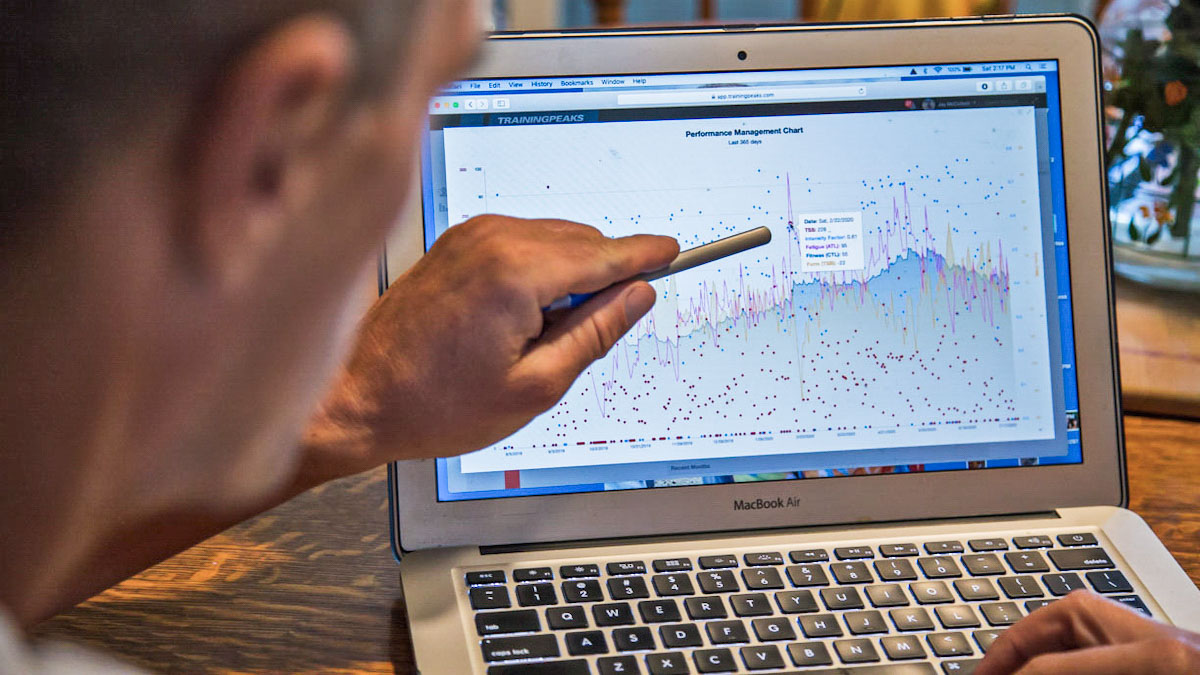As the current season winds down and you enter your end-of-season ‘transition period‘, it’s time for season review. Make the most of the downtime with these season review strategies while your past season is fresh in your mind. During the review process, you want to take a look at what you accomplished from a training and performance progression standpoint; along with the training volume you accomplished, your consistency in training, and what went well for you and where you could improve upon for next season.
Season Review: Performance Management Chart
A great place to begin your season review is to take a look back at the work you’ve put in over your past season. This can be easily achieved by looking at your Performance Management Chart within your TrainingPeaks app. If you’re not a TrainingPeaks user, most training-log applications offer some version of this chart that displays the work you’ve accomplished over a selected time period.
Chronic Training Load
Your Chronic Training Load (CTL) is represented by the blue line on the chart. This graphically displays the progression of your fitness as days, weeks, and months accumulate. It is common to see a ‘saw-tooth’ pattern in the line. Ideally your CTL increases over the course of several weeks and months with minimal dips along the way. The gradual growth indicates consistency in training, and the small declines indicate recovery days and recovery weeks.
Acute Training Load vs. Freshness
The pink line represents your Acute Training Load (ATL). This indicates your level of fatigue; whereas the yellow line represents your freshness or readiness to perform. These lines are inverse of each other. To put simply, the harder you train the more tired your legs get and the less able are you to hit a peak performance. Vice versa when you recover a bit your fatigue comes down and your freshness or ability to put out a great effort increases.
Key Points to Reference:
- How successful were you in building your fitness over the ‘base training’ months?
- How many weeks of training were implemented for your growth in CTL?
- What kind of ‘ramp rate’ did you achieve? Was this successful or stressful for you?
- What was your peak CTL value at the end of Base?
- What did your CTL drop to within your race preparation training prior to a peak performance?
- Did you achieve a peak performance?
These values can be helpful in designing your Annual Training Plan for the next season. With some experience, you can begin to determine what values ‘work for you’ in terms of building fitness & fatigue, and where you are likely to achieve peak fitness and a peak performance.
PMC Example
I’ll use my 2020 Performance Manager Chart as an example of the season review thought process…
The first half of my 2020 season was dedicated to base building. Eight weeks of easy fall base miles progressed CTL from around 70 to a little over 80 before a recovery week (ramp rate of 5/month). In the four months that followed, I built CTL from around 70 to 110 (ramp rate of 10/month). At this point fitness was high, as was Acute Training Load (ie. physical stress). A week off the bike was planned (family vacation); but that was followed by me catching influenza-A and needing another 2 weeks to return to health… CTL plummeted to around 75!
In the second half of my season, my motivation was high (following the flu) as the COVID-19 lockdowns escalated and racing was canceled. It was decided to return to base training with Aerobic Threshold & Anaerobic Threshold training blocks. Ramp rates were much steeper (indicated by blue CTL line) since months of base fitness were recently built prior to illness. Following the Anaerobic block of training, fitness was high (end of May) and freshness was on the rise (yellow TSB line)… leading to ‘peak performances’ in testing and Strava KOMs in early June.
A mid-season break occurred in mid-June. Freshness returned and allowed for another 12-week round of aerobic miles, Aerobic Threshold and Anaerobic training blocks; we dubbed it our Season Salvation Plan. This solid training took CTL from 85 to 115 (peak of season) over 8 weeks building high levels of fitness & fatigue. During the final high-intensity block, freshness returned and was soon followed by a second ‘peak’ indicated by further PRs in testing efforts and more Strava KOMs!
I can now determine that building fitness to around 110-115 over stretches of base-building blocks, followed by high-intensity training blocks allowing CTL to drop into the 90s and freshness to rise, I can expect some solid performances. This is valuable information I can incorporate as I plan my 2021 season.
Season Review: Weekly TSS
Another valuable chart to reference in your review is the Weekly TSS Total. This chart depicts your weekly training load achieved through weekly Training Stress Scores and Intensity Factor (averaged for the week). This provides a graphical view of the overall load of each week and related level of intensity. Again, you want to identify your peaks, valleys, and consistency in your training over the previous months.
Key Points to Reference:
- Your average weekly TSS for the season (indicated by dashed line)?
- Peak TSS weeks per training block?
- Maximum TSS week for your season?
- Consistency in your weekly training progressions… Did you organize effective training blocks?
- How many recovery weeks did you take? Was there enough? Was there too many?
These values will again assist you in creating your training loads for your next season. If things went well this year, then you can model your next year after these numbers – perhaps even consider increasing your loads a small amount from year to year. If your season progressions or performances did not live up to your goals, try to identify where you went awry… too high of training load, not enough recovery, not enough consistency, or ineffective training blocks are frequently the issues cyclists encounter.
Example
Using my 2020 season again as an example, we can easily view the consistency in training, placements of recovery weeks, and the loading progressions within the training blocks…
Average weekly TSS was 600. Peak loads were progressive between training blocks: around 800 for the fall base miles, 900 for winter base building, 1000 for the early summer blocks, and a max TSS week for the year was almost 1100 at the end of my final build.
The consistency in training appears effective with the exception of the visible early March influenza-A interruption. Otherwise, training blocks were consistent and recovery weeks well placed within the year. The lack of racing due to COVID-19 for 2020 allowed for ideal training progression throughout the entire year. In a normal year, with frequent racing from March through September, I would not normally see the visually appealing structured training blocks. This lack of racing allowed for ideal training; as a result, PRs in testing efforts and KOMs on Strava were achieved.
The next objective will be to use this information to design next year’s training progressions in similar fashion with the peaks in fitness to line up with A-priority events in the new season ahead. As interesting as an experiment this 2020 season has been, let’s all cross our fingers for a ‘normal’ 2021 season full of events!









